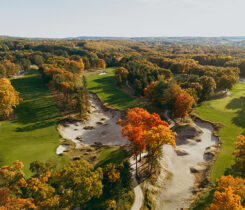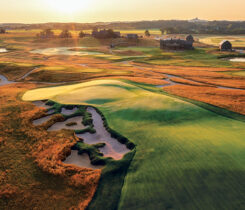A look at factors impacting tissue N content in creeping bentgrass
This study aimed to quantify how different nitrogen (N) application rates, foot traffic intensities, soil volumetric water content (VWC) and weather factors influence the tissue N content of Focus creeping bentgrass (Agrostis stolonifera L.)
Tissue N content indicates N removal in clippings from putting greens. We wanted to understand the factors controlling turfgrass tissue N content to help superintendents determine the average tissue N content.
Often, superintendents apply a moderate N rate to limit the turfgrass growth rate which keeps turfgrass in a state of N deficiency. Most superintendents make N application decisions based on their subjective assessment and usually do not quantify turfgrass growth. However, the use of area-normalized fresh clipping volume to quantify turfgrass growth has become popular with some in recent years.
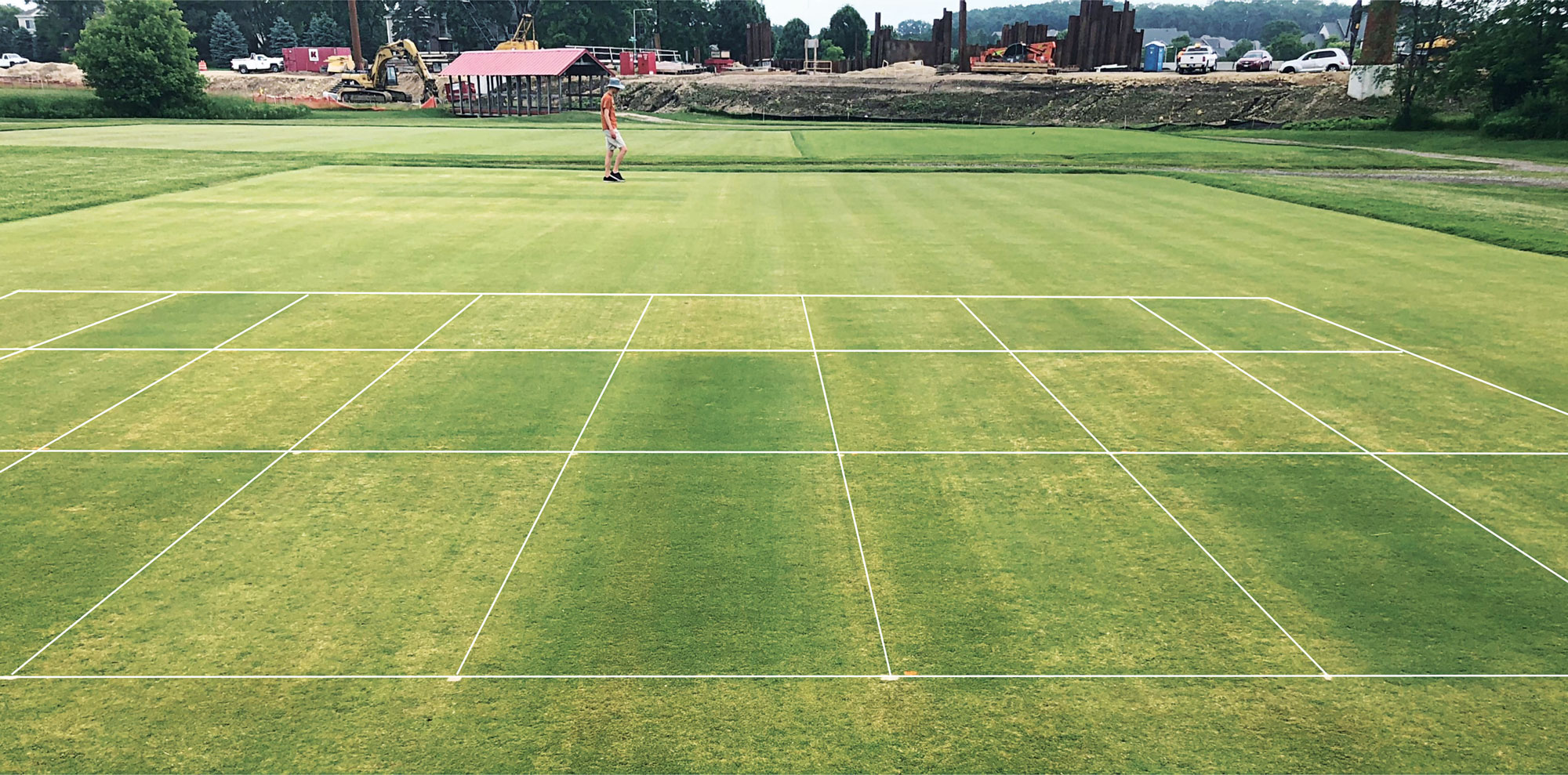
Nitrogen is the main factor controlling tissue nitrogen content in creeping bentgrass compared to weather, irrigation and foot traffic. (Photo: Qiyu Zhou and Douglas J. Soldat)
Fresh clipping volume and tissue N content can approximate N uptake and removal. However, daily mowing of greens makes tissue N content from each mowing impractical. Instead, the manager may wish to submit a few samples during the year to average the results or assume a tissue N content without sending in a sample.
Studies have documented how weather, traffic and water influence turfgrass growth (2 and 5), but little research has been done on how these factors influence tissue N content.
Foot traffic on putting greens is a major stress on turfgrass and usually harms turfgrass performance (3). Excessive traffic stress can significantly damage turf and reduce turf quality and clipping yield (1,10 and 11). However, there is limited information on if or how foot traffic affects tissue N content.
Water availability is another critical factor for plant growth. Water deficiency can sometimes be the primary growth-limiting factor (7 and 12). On the other hand, excessive irrigation also harms creeping bentgrass growth and visual quality (4). Excessive irrigation can result in increased vulnerability to traffic and disease stress.
Understanding how water availability influences creeping bentgrass tissue N content is necessary for precise N management. Tissue N content is essential for accurately estimating plant N uptake. As data-driven N management continues to grow, there is a need to understand thoroughly the factors affecting turfgrass N status. Therefore, our research investigates the significance of weather, traffic and management factors on tissue N content in creeping bentgrass.
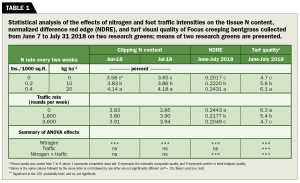
Table 1
Materials and Methods
During 2018 and 2019, we conducted two field experiments at the University of Wisconsin-Madison O.J. Noer Turfgrass Research and Education Facility in Verona, Wis. The research area was on two Focus creeping bentgrass putting greens on sand root zones constructed following USGA recommendations for putting green construction (13).
We managed the putting greens in the following manner:
- Mowed five days per week at a height of cut at 0.125 inches (3.2 mm)
- Irrigated daily to replace evapotranspiration (ET) estimated by an on-site weather station (except when irrigation was a treatment.)
- Fertilized with 10 applications of 0.2 lbs. per 1,000 ft2 (10 kg ha−1) of N as urea (except when N fertilizer was
a treatment.) - Topdressed with 0.3 yards3 per acre (0.6 m3 ha−1) of sand approximately every three weeks during the growing season.
- Hollow-tine cultivation once a year at the end of the growing season and filled holes with topdressing sand.
- Controlled diseases and other pests as needed.
The first of two field experiments evaluated the combined effects of foot traffic and nitrogen fertilizer on tissue N content on two greens with 0.6 and 0.9 percent soil organic matter (SOM). We applied N fertilizer at 0, 0.2 or 0.4 lbs. per 1000 ft2 (0, 10 or 20 kg N ha−1) every two weeks and maintained foot traffic intensity at three rates: 0, 1,800 and 3,600 rounds per week from May 16 to Aug. 28, 2018 (6). Five researchers wearing golf shoes walked on the plots to simulate traffic.
We collected clippings from each plot in the morning three times a week from June 7 to July 31, 2018 (weather permitting). The effective clipping collection area for each plot was 1.0 m2. We brushed clippings from the mower bucket into paper bags and then placed them in a 50 C oven for at least 48 hours. The water method removed sand and debris from dried clipping samples (8). The clippings were then ground into fine powder to determine the total N content in a combustion analyzer with thermal conductivity detection.
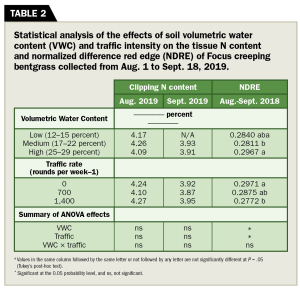
Table 2
Visual turfgrass quality for each plot was evaluated every two weeks from June 7 to July 31, 2018, on a one to nine scale, where one represents completely dead turf, six represents minimally acceptable quality and nine represents perfect or ideal turfgrass quality (9). We recorded the normalized difference red edge (NDRE) for each plot on the same dates.
In the second field experiment, we examined the combined effects of volumetric water content (VWC) and traffic on tissue N content on a green with 0.9 percent SOM. Volumetric water content was maintained at low (12 to 15 percent), medium (17 to 22 percent) and high (25 to 29 percent) levels by hand-watering. We used a FieldScout TDR 350 Soil Moisture Meter with 3-inch rods before each clipping collection event to help maintain the different VWC. Foot traffic intensities were 0, 700 and 1,400 weekly rounds from May 31 to Oct. 4, 2019. We collected clippings and N tissue analysis, as mentioned above.
The tissue N content ranged from 2.5 to 5.0 percent (average: 3.9 percent). The N fertilizer rate was the main factor controlling the tissue N content, but foot traffic and VWC had no impact. Temperature, relative humidity and evapotranspiration on the tissue N content also had minimal or nonexistent impacts.
Results and Discussion
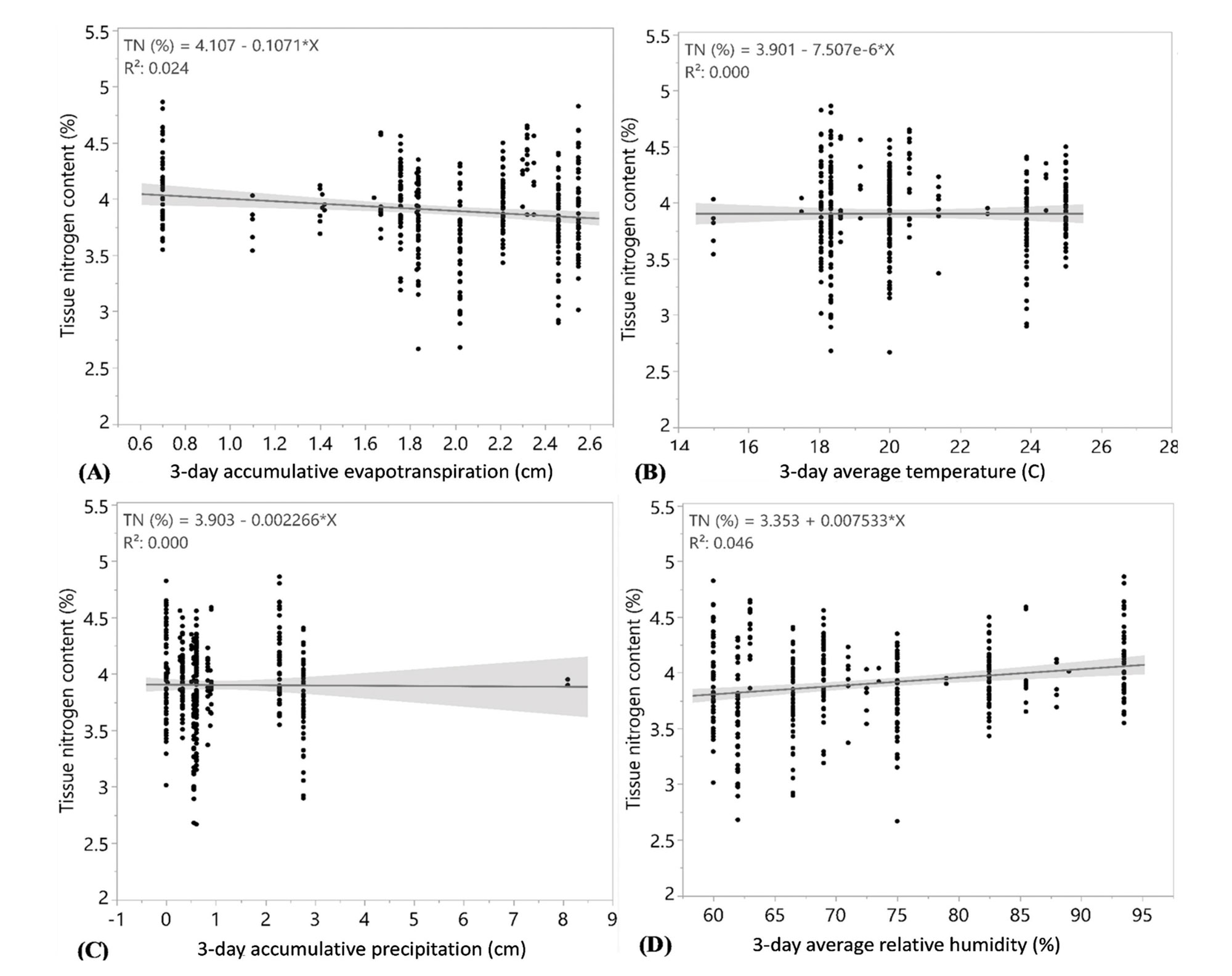
(Fig 2) Relationship between weather factors and creeping bentgrass tissue nitrogen content.
The N fertilizer treatments caused small but significant differences in the tissue N content in clippings collected on two greens in June and July 2018 (Table 1). The SOM caused no significant difference in the tissue N content (data not shown). This might be because the difference in SOM between the two research greens was small. Future studies with a wide range of SOM would be needed to investigate the effect of SOM on turfgrass tissue N content.
In this study, on both research greens, doubling the fertilization 0.2 to 0.4 lbs. per 1000 ft2 (from 10 to 20 kg ha-1) every two weeks increased the tissue N content by 8 percent, whereas increasing the fertilization from 0 to 0.2 lbs. per 1000 ft2 (0 to 10 kg ha-1) resulted in an increase of 6 to 7 percent in plant tissue N content. There was a relatively strong relationship between tissue N content and N fertilization rate (R2 = 0.34), and N fertilization inherently improved the turfgrass visual quality ratings and NDRE values.
Foot traffic did not impact the tissue N content (Table 1) in the 2018 field study, despite ranging from no to high traffic (3,600 rounds per week). Increasing the traffic intensity decreased NDRE and turfgrass visual quality (Table 1).
In 2019, traffic intensities maintained at 0, 700 and 1,400 rounds per week also had no statistical influence on the tissue N content (Table 2), and increasing the traffic intensity decreased the NDRE values. These results demonstrated that NDRE might not be an accurate tool for predicting tissue N content, especially across areas that are affected differently by traffic stress. The VWC also did not impact the tissue N content (Table 2).
Overall, weather factors in this study, including the average air temperature, ET and relative humidity, played a small role in controlling the tissue N content collected in 2018 and 2019 (Figure 1). In Wisconsin, the summer range of weather parameters was limited.
Daily average temperatures spanned from 12 to 28 C, mean relative humidity ranged from 57 to 98 percent and ET ranged from 0.2 to 0.7 cm. Over this period, there was a relatively wide range in tissue N content from the individual plots, and the majority of samples fell between 2.5 and 5 percent, with a mean value of 3.9 percent.
Conclusion
Nitrogen fertilization was strongly related to tissue N content in Focus creeping bentgrass. Foot traffic, VWC and several weather factors, including temperature, relative humidity and ET, all had slight to no correlations with the tissue N content. The average tissue N content was 3.9 percent under our field experiments various management conditions and weather.
When the N fertilization rate increased from 0 to 0.4 lbs. per 1000 ft2 (0 to 20 kg N ha−1) every two weeks, the average tissue N content only increased from 3.6 to 4.1 percent. Our results show that the tissue N content of typically managed creeping bentgrass putting green turf is about 4 percent, and irrigation practices, foot traffic or weather factors do not strongly influence it. Turfgrass managers may be able to determine a robust average tissue N content for their creeping bentgrass putting greens by periodically (randomly) collecting samples and averaging them.









